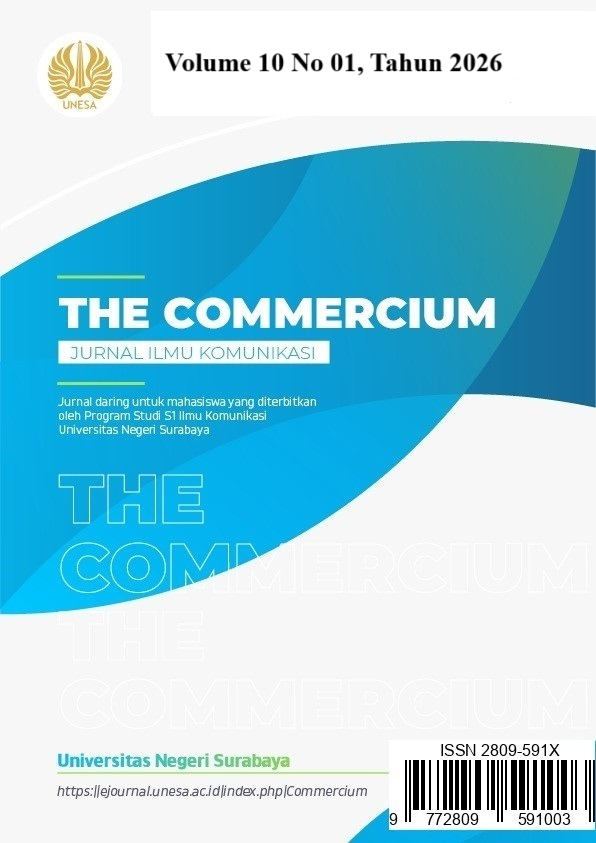Pengalaman Menonton Program TV Infotaiment di Era Internet Studi Fenomenologi Pada Perempuan Millennial Urban
DOI:
https://doi.org/10.26740/tc.v10i1.72589Keywords:
infotaiment, media sosial, perempuan milineal, fenomenologi, pengalaman mediaAbstract
Penelitian ini bertujuan untuk memahami pengalaman perempuan milenial urban
dalam mengonsumsi program infotainment di era internet. Dengan menggunakan pendekatan
fenomenologi, penelitian ini mengeksplorasi bagaimana makna dan pengalaman subjektif
terbentuk dalam proses pergeseran konsumsi dari televisi ke media sosial. Hasil penelitian
menunjukkan bahwa konsumsi infotainment oleh perempuan milenial tidak lagi bersifat pasif,
melainkan merupakan strategi adaptif terhadap kehidupan multitugas dan digital yang
menuntut fleksibilitas. Media sosial dipilih karena mampu menyediakan hiburan secara cepat,
personal, dan emosional. Informan mengalami keterlibatan emosional semu (parasosial)
dengan selebriti, memanfaatkan infotainment sebagai bentuk pelarian dan perawatan diri
emosional, serta menggunakannya sebagai alat komunikasi sosial. Selain itu, terdapat
ambiguitas dalam menyikapi validitas informasi, di mana informan lebih mengutamakan
kecepatan dan kedekatanemosional daripada akurasi jurnalistik. Penelitian ini menegaskan
bahwa konsumsi infotainment di era digital merupakan praktik budaya yang reflektif dan
kompleks, yang mencerminkan hubungan baru antara media, individu, dan emosi dalam
lanskap komunikasi kontemporer.
Downloads
References
Atmoko, B., & Rachmawati, I. (2022). Interaksi
parasosial di era media sosial: Studi
pada penggemar selebriti Instagram. Jurnal Komunikasi, 14(2), 115–127. https://doi.org/10.1234/jkom.v14i2.202
2
Creswell, J. W. (2017). Qualitative inquiry and
research design: Choosing among five
approaches (4th ed.). SAGE
Publications. Horton, D., & Wohl, R. R. (1956). Mass
communication and para-social
interaction: Observations on
intimacy at a distance. Psychiatry, 19(3), 215–229.
Lim, H. S., & Choe, J. Y. (2020). Parasocial
interaction in social media and its
effect on intention to purchase. Journal
of Retailing and Consumer
Services, 54, 102030. Lichtman, M. (2021). Qualitative research
in education: A user’s guide (5th
ed.). SAGE Publications. Marwick, A. E. (2013). Status Update:
Celebrity, Publicity, and Branding in
the Social Media Age. Yale
University Press
McIntyre, L. (2018). Post-Truth. MIT Press
McQuail, D. (2010). McQuail’s mass
communication theory (6th ed.). SAGE Publications
Moustakas, C. (1994). Phenomenological
research methods. SAGE
Publications. Nabi, R. L. (2009). Media and emotion. In J. Bryant & M. B. Oliver (Eds.), Media
effects: Advances in theory and
research (pp. 103–121). Routledge. Pariser, E. (2011). The Filter Bubble: What
the Internet Is Hiding from You. Penguin Press. Ruggiero, T. E. (2000). Uses and
gratifications theory in the 21st century. Mass Communication
and Society, 3(1), 3–37. https://doi.org/10.1207/S15327825
MCS0301_02
Storey, J. (2018). Cultural Theory and
Popular Culture: An Introduction
(8th ed.). Routledge. Susanto, H., & Prasetya, A. W. (2020). Adaptasi teori uses and gratification
dalam konsumsi media digital di
kalangan remaja perkotaan. Jurnal
Ilmu Komunikasi, 17(2), 101–115. https://doi.org/10.24002/jik.v17i2.45
67
Tsiotsou, R. H. (2015). The role of social
and parasocial relationships on social
networking sites loyalty. Computers in Human Behavior, 48, 401–414. https://doi.org/10.1016/j.chb.2015.0
1.064
Tukachinsky, R. (2011). Para-romantic love
and para-friendships: Development
and assessment of a multiple- parasocial relationships scale. American Journal of Media
Psychology, 4(1/2), 73– 94.
The Commercium. Volume 10 Nomor 10, Tahun 2026, - Wang, Z., & Tchernev, J. M. (2012). The
‘myth’ of media multitasking:
Reciprocal dynamics of media
multitasking, personal needs, and
gratifications. Journal of
Communication, 62(3), 493–513. Zillmann, D. (2000). Mood management in
the context of selective exposure
theory. In M. Roloff (Ed.), Communication Yearbook 23 (pp. 103–123). SAGE Publications.
Downloads
Published
How to Cite
Issue
Section
 Abstract views: 48
,
Abstract views: 48
, PDF Downloads: 50
PDF Downloads: 50

